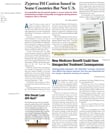By the time Selena Walker became involved with the Blended Funding Project at age 15, she'd been ousted by a number of residential facilities and psychiatric programs whose staff declared that she was “too tough” or “too difficult.”
According to her mother, Tammy Walker, Selena's difficulties began in early childhood and intensified as she grew older. She often acted on aggressive and self-destructive impulses, endangering the safety of herself and others.
When Selena was 9, Walker placed her in a group home. “She stabbed me with a butcher knife, and at that point I knew she was more than I could handle,” Walker told Psychiatric News.
Her aggressive and self-harming behavior did not abate in the group home, and Selena was transferred after a year because she was deemed “too tough” for staff to manage.
Over Walker's objections, state administrators sent Selena to a group home in Spokane, Wash., more than 300 miles from where Tammy Walker lives and works in Seattle as an information-technology specialist.
But that stay, as well as the psychiatric hospitalization that followed, was short-lived.
This wasn't true of her next placement at the Child Study and Treatment Center at Western State Hospital in Tacoma. While the average length of stay is nine months, Selena stayed for more than five years.
Tammy Walker noted that few of the children at the state hospital had contact with their families, but she was involved to the point where she assumed the role of Selena's case manager for the state.
By this time, Walker noted, Selena had seen a number of psychiatrists and mental health professionals and tried several treatment modalities, none of which seemed to help.
However, during her fourth year of hospitalization, Selena began receiving dialectic behavioral therapy (DBT), and “we started seeing positive results,” her mother said. The DBT enabled Selena to cope with strong emotions in a constructive way, rather than using maladaptive behaviors, such as cutting herself, destroying property, or acting out.
Months after Selena's behavior began to improve, there was pressure from hospital administrators to discharge her to a community setting.
“I asked them, `How can you discharge her so soon?'” Walker said. “Up until that time, Selena had nothing but failures and problems with treatment.”
Despite Walker's concerns, Selena was discharged to a less-restrictive setting—a group home for young women with mental illness—and began to decompensate again.
The self-injurious and violent behavior resumed, as did the multiple and serious suicide attempts. Selena had to be transferred out of the home after one year there.
While at the residential facility, Walker said, Selena began receiving services through the Blended Funding Project. Walker, who had acted as her daughter's case manager for years, led the team of family, friends, and clinicians who dedicated themselves to Selena's recovery and “decided how funds set aside for Selena could best be spent,” she said (see
page 20).
Many of her daughter's subsequent placements, such as treatment at Seattle-area outpatient mental health programs combined with psychiatric hospitalization at night, were coordinated and paid for through the Blended Funding Project, Walker said.
Due to a bout of violent behavior when she was 17, Selena was sentenced to a year in a juvenile-justice facility. The Blended Funding Project enabled Selena to serve her sentence at Echo Glen, a facility in which women with mental illness are treated with DBT. Selena worked diligently in treatment, according to Walker, and improved.
While Selena served her sentence, the Blended Funding Project enabled Walker and her husband to receive counseling.
Since her release, Selena, now 22, has made no suicide attempts and has been living in the community.
“She still struggles, but she is out there making her way,” Walker said, crediting the Blended Funding Project with the stability Selena has found as a young adult.
“The skills and experience Selena use today to live on her own she acquired through the Blended Funding Project,” her mother said.
“This project went to the mat for Selena. What we see today is that, despite the odds, Selena is a rousing success.” ▪
